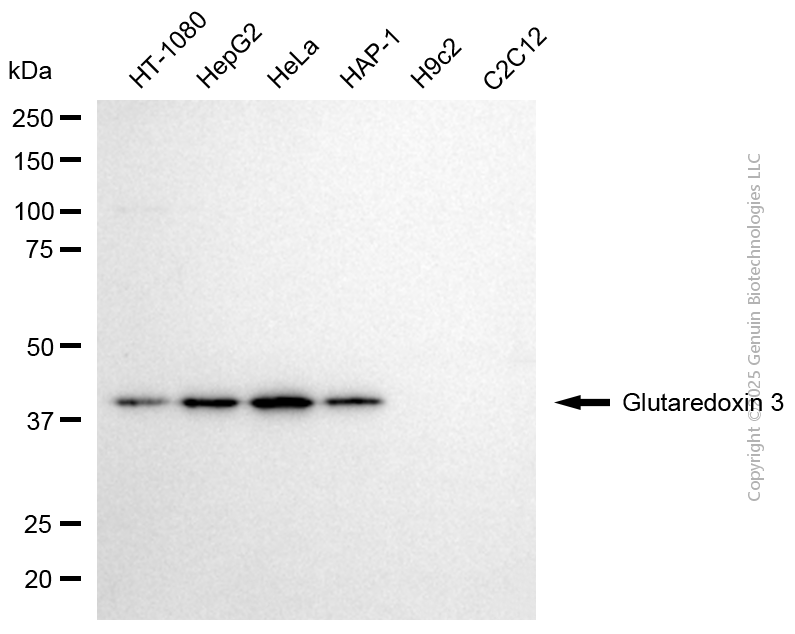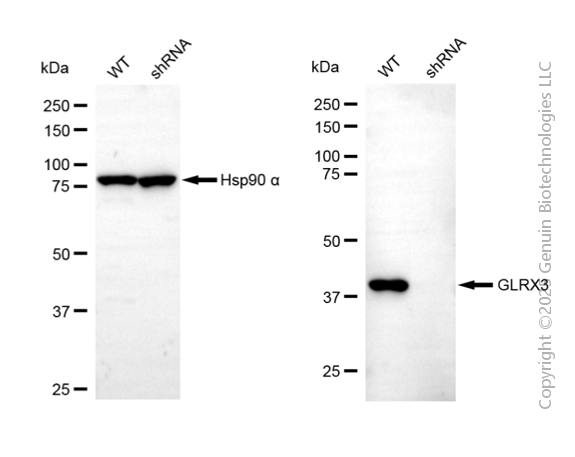KD-Validated Anti-Glutaredoxin 3 Mouse Monoclonal Antibody
Mouse monoclonal antibody
- SPECIFICATION
- CITATIONS
- PROTOCOLS
- BACKGROUND

Application
| WB |
|---|---|
| Primary Accession | O76003 |
| Reactivity | Human |
| Clonality | Monoclonal |
| Isotype | Mouse IgG2a |
| Clone Names | 24GB13145 |
| Calculated MW | Predicted, 37 kDa, observed, 38 kDa |
| Gene Name | GLRX3 |
| Aliases | GLRX3; Glutaredoxin 3; PICOT; GLRX4; TXNL2; GRX3; GRX4; PKC-Interacting Cousin Of Thioredoxin; PKC-Theta-Interacting Protein; Thioredoxin-Like Protein 2; PKCq-Interacting Protein; Glutaredoxin 4; Glutaredoxin-3; BA500G10.4; Testicular Tissue Protein Li 75; Thioredoxin-Like 2; TXNL3 |
| Immunogen | Recombinant protein of human GLRX3 |
| Gene ID | 10539 |
|---|---|
| Other Names | Glutaredoxin-3, PKC-interacting cousin of thioredoxin, PICOT, PKC-theta-interacting protein, PKCq-interacting protein, Thioredoxin-like protein 2, GLRX3, PICOT {ECO:0000303|PubMed:10636891}, TXNL2 |
| Name | GLRX3 |
|---|---|
| Synonyms | PICOT {ECO:0000303|PubMed:10636891}, TXN |
| Function | Together with BOLA2, acts as a cytosolic iron-sulfur (Fe-S) cluster assembly factor that facilitates [2Fe-2S] cluster insertion into a subset of cytosolic proteins (PubMed:26613676, PubMed:27519415). Acts as a critical negative regulator of cardiac hypertrophy and a positive inotropic regulator (By similarity). Required for hemoglobin maturation (PubMed:23615448). Does not possess any thyoredoxin activity since it lacks the conserved motif that is essential for catalytic activity. |
| Cellular Location | Cytoplasm, cytosol. Cytoplasm, cell cortex. Cytoplasm, myofibril, sarcomere, Z line {ECO:0000250|UniProtKB:Q9CQM9}. Note=Under the plasma membrane (By similarity). After PMA stimulation, GLRX3 and PRKCQ/PKC-theta translocate to a more extended submembrane area (By similarity). In the Z line, found associated with CSRP3 (By similarity). {ECO:0000250|UniProtKB:Q9CQM9} |
| Tissue Location | Expressed in heart, spleen, testis and, to a lower extent, in thymus and peripheral blood leukocytes. Weakly expressed in lung, placenta, colon and small intestine |

Thousands of laboratories across the world have published research that depended on the performance of antibodies from Abcepta to advance their research. Check out links to articles that cite our products in major peer-reviewed journals, organized by research category.
info@abcepta.com, and receive a free "I Love Antibodies" mug.
Provided below are standard protocols that you may find useful for product applications.
If you have used an Abcepta product and would like to share how it has performed, please click on the "Submit Review" button and provide the requested information. Our staff will examine and post your review and contact you if needed.
If you have any additional inquiries please email technical services at tech@abcepta.com.













 Foundational characteristics of cancer include proliferation, angiogenesis, migration, evasion of apoptosis, and cellular immortality. Find key markers for these cellular processes and antibodies to detect them.
Foundational characteristics of cancer include proliferation, angiogenesis, migration, evasion of apoptosis, and cellular immortality. Find key markers for these cellular processes and antibodies to detect them. The SUMOplot™ Analysis Program predicts and scores sumoylation sites in your protein. SUMOylation is a post-translational modification involved in various cellular processes, such as nuclear-cytosolic transport, transcriptional regulation, apoptosis, protein stability, response to stress, and progression through the cell cycle.
The SUMOplot™ Analysis Program predicts and scores sumoylation sites in your protein. SUMOylation is a post-translational modification involved in various cellular processes, such as nuclear-cytosolic transport, transcriptional regulation, apoptosis, protein stability, response to stress, and progression through the cell cycle. The Autophagy Receptor Motif Plotter predicts and scores autophagy receptor binding sites in your protein. Identifying proteins connected to this pathway is critical to understanding the role of autophagy in physiological as well as pathological processes such as development, differentiation, neurodegenerative diseases, stress, infection, and cancer.
The Autophagy Receptor Motif Plotter predicts and scores autophagy receptor binding sites in your protein. Identifying proteins connected to this pathway is critical to understanding the role of autophagy in physiological as well as pathological processes such as development, differentiation, neurodegenerative diseases, stress, infection, and cancer.



